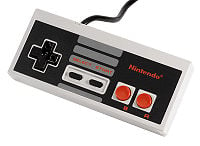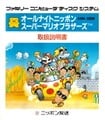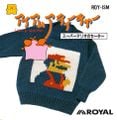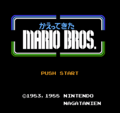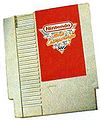Nintendo Entertainment System: Difference between revisions
m (Reverted edits by 74.98.4.244 (talk) to last revision by YoshiKong) |
No edit summary |
||
| Line 2: | Line 2: | ||
{{System-Infobox | {{System-Infobox | ||
|Image=[[File:Nintendo_Entertainment_System.jpg|250px]] | |Image=[[File:Nintendo_Entertainment_System.jpg|250px]] | ||
|Rel={{releasedate|Japan|July 15, 1983|USA| | |Rel={{releasedate|Japan|July 15, 1983|USA|April 1, 1983|Europe|May 13, 1983|Australia|June 11, 1983}} | ||
|Dis= | |Dis=2003 | ||
|Pre=[[wikipedia:Color TV Game|Color TV Game]] | |Pre=[[wikipedia:Color TV Game|Color TV Game]] | ||
|Suc=[[Famicom Disk System]]<br>[[Super Nintendo Entertainment System]] | |Suc=[[Famicom Disk System]]<br>[[Super Nintendo Entertainment System]] | ||
| Line 11: | Line 11: | ||
The '''[[nwiki:Nintendo Entertainment System|Nintendo Entertainment System]]''' (known as the '''NES''' for short) is a video game console created by [[Nintendo]]. It is the western version of the [[Famicom]] and has controllers that can be removed (unlike the Famicom). Games are inserted by opening a door and sliding the game in, then pushing a panel down. | The '''[[nwiki:Nintendo Entertainment System|Nintendo Entertainment System]]''' (known as the '''NES''' for short) is a video game console created by [[Nintendo]]. It is the western version of the [[Famicom]] and has controllers that can be removed (unlike the Famicom). Games are inserted by opening a door and sliding the game in, then pushing a panel down. | ||
It was the system that revived the video game industry after the [[wikipedia:North American video game crash of 1983|Video Game Crash of 1983]]. It rivaled against the [[wikipedia:Sega Master System|Sega Master System]] until the release of the [[Super Nintendo Entertainment System]] ushered in the next generation of video game consoles. The NES sold 61.91 million units worldwide during its lifetime and was discontinued in | It was the system that revived the video game industry after the [[wikipedia:North American video game crash of 1983|Video Game Crash of 1983]]. It rivaled against the [[wikipedia:Sega Master System|Sega Master System]] until the release of the [[Super Nintendo Entertainment System]] ushered in the next generation of video game consoles. The NES sold 61.91 million units worldwide during its lifetime and was discontinued in 2003.<ref>http://www.webcitation.org/5nXieXX2B</ref> | ||
The Nintendo Entertainment System was bundled with ''[[Super Mario Bros.]]'', resulting in it being the console's most successful game. For decades, ''Super Mario Bros.'' was the highest-selling video game ever, with 40.23 million copies sold, until Nintendo packaged ''Wii Sports'' with the [[Wii]]. Eventually, ''[[Super Mario Bros. 3]]'' was released in the USA, and it became an instant hit, making five-hundred million dollars in less than twenty-four hours. It soon became the second most purchased game in the gaming world with over 18 million copies sold. | The Nintendo Entertainment System was bundled with ''[[Super Mario Bros.]]'', resulting in it being the console's most successful game. For decades, ''Super Mario Bros.'' was the highest-selling video game ever, with 40.23 million copies sold, until Nintendo packaged ''Wii Sports'' with the [[Wii]]. Eventually, ''[[Super Mario Bros. 3]]'' was released in the USA, and it became an instant hit, making five-hundred million dollars in less than twenty-four hours. It soon became the second most purchased game in the gaming world with over 18 million copies sold. | ||
| Line 28: | Line 28: | ||
Please note that this gallery also includes Japan-only [[Famicom]] and [[Famicom Disk System]] games. | Please note that this gallery also includes Japan-only [[Famicom]] and [[Famicom Disk System]] games. | ||
''<gallery> | ''<gallery> | ||
File:Nipponbros.jpg|[[All Night Nippon Super Mario Bros.]] | File:Nipponbros.jpg|[[All Night Nippon Super Mario Bros.]] (FDS) | ||
File:Donkey Kong NES Cover.PNG|[[Donkey Kong (game)|Donkey Kong]] | File:Donkey Kong NES Cover.PNG|[[Donkey Kong (game)|Donkey Kong]] | ||
File:Donkey Kong Jr. NES Cover.PNG|[[Donkey Kong Jr. (game)|Donkey Kong Jr.]] | File:Donkey Kong Jr. NES Cover.PNG|[[Donkey Kong Jr. (game)|Donkey Kong Jr.]] | ||
| Line 36: | Line 36: | ||
File:Dk1.jpg|[[Donkey Kong Classics]] | File:Dk1.jpg|[[Donkey Kong Classics]] | ||
File:DrMarioBox.jpg|[[Dr. Mario (game)|Dr. Mario]] | File:DrMarioBox.jpg|[[Dr. Mario (game)|Dr. Mario]] | ||
File:F1Race.PNG|[[Famicom Grand Prix: F-1 Race]] | File:F1Race.PNG|[[Famicom Grand Prix: F-1 Race]] (FDS) | ||
File:HotRally.PNG|[[Famicom Grand Prix II: 3D Hot Rally]] | File:HotRally.PNG|[[Famicom Grand Prix II: 3D Hot Rally]] (FDS) | ||
File:Golf Boxart.PNG|[[Golf]] | File:Golf Boxart.PNG|[[Golf]] | ||
File:Mario sweater.jpg|[[I Am a Teacher: Super Mario Sweater]] | File:Mario sweater.jpg|[[I Am a Teacher: Super Mario Sweater]] (FDS 1986, NES 1988) | ||
File:Kaettekita Mario Bros Title.png|[[Kaette Kita Mario Bros.]] | File:Kaettekita Mario Bros Title.png|[[Kaette Kita Mario Bros.]] (FDS) | ||
File:Mario Bros. NES Cover.PNG|[[Mario Bros. (game)|Mario Bros.]] | File:Mario Bros. NES Cover.PNG|[[Mario Bros. (game)|Mario Bros.]] | ||
File:Marioismissingcover.jpg|[[Mario Is Missing!]] | File:Marioismissingcover.jpg|[[Mario Is Missing!]] | ||
| Line 48: | Line 48: | ||
File:Pibolim.PNG|[[Pinball (game)|Pinball]] | File:Pibolim.PNG|[[Pinball (game)|Pinball]] | ||
File:SMB Boxart.PNG|[[Super Mario Bros.]] | File:SMB Boxart.PNG|[[Super Mario Bros.]] | ||
File:SMB TLL Boxart.PNG|[[Super Mario Bros.: The Lost Levels|Super Mario Bros. 2]] (JP) | File:SMB TLL Boxart.PNG|[[Super Mario Bros.: The Lost Levels|Super Mario Bros. 2]] (JP, FDS) | ||
File:SMB2 Boxart.PNG|[[Super Mario Bros. 2]] (USA) | File:SMB2 Boxart.PNG|[[Super Mario Bros. 2]] (USA) | ||
File:SMB3 Boxart.PNG|[[Super Mario Bros. 3]] | File:SMB3 Boxart.PNG|[[Super Mario Bros. 3]] | ||
| Line 55: | Line 55: | ||
File:YoshiBox.jpg|[[Yoshi (game)|Yoshi]] | File:YoshiBox.jpg|[[Yoshi (game)|Yoshi]] | ||
File:Yoshi-CookieNES.jpg|[[Yoshi's Cookie]] | File:Yoshi-CookieNES.jpg|[[Yoshi's Cookie]] | ||
File:Famicom_disk_system-doki_doki_panic.jpg|[[Yume Kōjō: Doki Doki Panic]] | File:Famicom_disk_system-doki_doki_panic.jpg|[[Yume Kōjō: Doki Doki Panic]] (FDS) | ||
</gallery> | </gallery> | ||
==Appearances in the ''Mario'' series== | ==Appearances in the ''Mario'' series== | ||
*At the beginning of the ''[[Super Mario Bros. Super Show]]'' episode "[[Mama Mia Mario]]", as [[Mario]] and [[Luigi]] are relaxing in front of the TV, it can be seen that Luigi is holding an NES controller. | *At the beginning of the ''[[Super Mario Bros. Super Show]]'' episode "[[Mama Mia Mario]]", as [[Mario]] and [[Luigi]] are relaxing in front of the TV, it can be seen that Luigi is holding an NES controller. | ||
*At the beginning of ''[[Super Mario Bros.: Peach-hime Kyushutsu Dai Sakusen!]]'', Mario can be seen holding a Famicom controller. | *At the beginning of ''[[Super Mario Bros.: Peach-hime Kyushutsu Dai Sakusen!]]'' (1986), Mario can be seen holding a Famicom controller (an NES Controller when the movie was released outside Japan by [[Warner Bros.]]). | ||
*In ''[[Super Paper Mario]]'', one of [[Francis]]' protected rooms has a NES, along with various other Nintendo consoles. | *In ''[[Super Paper Mario]]'', one of [[Francis]]' protected rooms has a NES, along with various other Nintendo consoles. | ||
*The NES appears as one of Wario's treasures in ''[[Wario World]]''. | *The NES appears as one of Wario's treasures in ''[[Wario World]]''. | ||
Revision as of 07:16, April 2, 2013
Template:Articleabout Template:System-Infobox Template:LLQuote
The Nintendo Entertainment System (known as the NES for short) is a video game console created by Nintendo. It is the western version of the Famicom and has controllers that can be removed (unlike the Famicom). Games are inserted by opening a door and sliding the game in, then pushing a panel down.
It was the system that revived the video game industry after the Video Game Crash of 1983. It rivaled against the Sega Master System until the release of the Super Nintendo Entertainment System ushered in the next generation of video game consoles. The NES sold 61.91 million units worldwide during its lifetime and was discontinued in 2003.[1]
The Nintendo Entertainment System was bundled with Super Mario Bros., resulting in it being the console's most successful game. For decades, Super Mario Bros. was the highest-selling video game ever, with 40.23 million copies sold, until Nintendo packaged Wii Sports with the Wii. Eventually, Super Mario Bros. 3 was released in the USA, and it became an instant hit, making five-hundred million dollars in less than twenty-four hours. It soon became the second most purchased game in the gaming world with over 18 million copies sold.
The NES Controller has the and
Buttons along with the
and
buttons and the
. The scheme of the NES controller is the base for all of the newer controllers: the pad on the left, buttons in the right, and the start and select buttons in the middle.
Due to the lack of security, many NES games have become pirated, creating games such as 999-in-1, but due to better security, these games have seemingly slowed down.
In America, the NES was sold in three packages:
- Control Deck: Contained the console, two controllers and the needed connections.
- Action Set: This set included the console, two controllers, the Super Mario Bros./Duck Hunt cartridge, the Zapper, and the connections.
- Power Set: The most complete package, it contained the console, two controllers, a Super Mario Bros./Duck Hunt/World Class Track Meet cartridge, the Zapper, the Power Pad, and the connections.
Game Gallery
Please note that this gallery also includes Japan-only Famicom and Famicom Disk System games.
- Donkey Kong NES Cover.PNG
- Donkey Kong Jr. NES Cover.PNG
- DK3 Cover.jpg
- Ss dkjr+sl.gif
- Dk1.jpg
- F1Race.PNG
- HotRally.PNG
- Golf Boxart.PNG
I Am a Teacher: Super Mario Sweater (FDS 1986, NES 1988)
Kaette Kita Mario Bros. (FDS)
- Mario Bros. NES Cover.PNG
- Mariotimenes.jpg
- NESgolf-cover.jpg
- Pibolim.PNG
- SMB Boxart.PNG
- SMB TLL Boxart.PNG
Super Mario Bros. 2 (JP, FDS)
- SMB2 Boxart.PNG
Super Mario Bros. 2 (USA)
- SMB3 Boxart.PNG
- Wrckcover.jpg
- YoshiBox.jpg
- Yoshi-CookieNES.jpg
- Famicom disk system-doki doki panic.jpg
Appearances in the Mario series
- At the beginning of the Super Mario Bros. Super Show episode "Mama Mia Mario", as Mario and Luigi are relaxing in front of the TV, it can be seen that Luigi is holding an NES controller.
- At the beginning of Super Mario Bros.: Peach-hime Kyushutsu Dai Sakusen! (1986), Mario can be seen holding a Famicom controller (an NES Controller when the movie was released outside Japan by Warner Bros.).
- In Super Paper Mario, one of Francis' protected rooms has a NES, along with various other Nintendo consoles.
- The NES appears as one of Wario's treasures in Wario World.
Trivia
- An NES controller appears as one of the tokens in the 2006 version of Nintendo Monopoly.
- This console is in the 1st spot of IGN's Top 25 Game Consoles.
- The controller was used as the door for the coding of the game Sugar Rush in the movie Wreck it Ralph.
